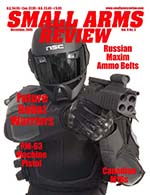Switch No. 10
By Anders Thygesen
DEVELOPMENT
The Switch No.10, commonly known as the “time-pencil,” is a small and compact delayed-ignition device that could set off a detonator or a Bickford safety fuze. The switch originated in Germany in 1916, but the idea was later adopted by the Poles. It was on a trip to Poland in 1939 that Brig. Colin McVean Gubbins brought an example of the time-pencil back home to England. Section D, the forerunner for the S.O.E. (Special Operation Executive), soon saw the potential of the time-pencil and hereafter Cdr. A.G. Langley further developed and improved it ending up with the product that we know today as the Switch No.10. It was widely used during the Second World War by S.O.E. operatives but certainly also by the O.S.S. (Office of Strategic Service). Around 18 million time-pencils were produced by S.O.E.
DESCRIPTION
It is generally understood that the glass ampoule contains acid and that it is the thickness of the steel wire that causes the various delays that are available in different time-pencils. This is, however, not the case. The steel wire has the same thickness regardless of the delay.
The pencil is composed of three different sections. The copper tube contains a clear glass ampoule filled with a green liquid being copper chloride and the brass tube is the housing for the striker, coil spring and a primer. Aluminium tubes can be found as a substitute for the common brass tube depending on who manufactured the pencils.
At the end of the brass tube, a spring snout is mounted, which allows a detonator No. 27 or a Bickford safety fuze to be inserted. The interior wall between the copper and brass tube is perforated by a 0.02 inch (0.5 millimetre) hole, in which the steel wire holding the striker under tension runs through. The other end of the wire is fixed to the screw and lead disk on the top of the copper tube. The total length of the pencil is 5 inches (127 millimetres), the diameter is 0.31 inch (8 millimetres) and the weight is 0.65 ounce (18.5 gram).
FUNCTION
Arming the time-pencil is done by squeezing the copper tube with the fingers, thereby crushing the glass ampoule inside. The solution of copper chloride is released and will immerse the steel wire. If the safety strip can then be removed without any friction, the time-pencil is armed. If the safety strip cannot be removed, it is because the steel wire has broken and thereby released the striker which is now resting on the safety strip under high tension caused by the spring. For ease of inspection, one or two inspection holes have been drilled next to the safety strip. The technical explanation of the process is that when the iron wire, a non-precious metal, is submerged into the copper chloride, an electrochemical transfer of the copper particles takes place. The copper will deposit on the iron wire and at the same time a corresponding amount of iron will be dissolved from the wire causing this to rapidly corrode and eventually break. The higher the concentration of copper chloride the faster it will corrode. The chemical formula is: Fe + Cu2+ -> Fe2+ + Cu.
TIMINGS
The period of delay is indicated by the color of the safety strip. The times given are for 59° Fahrenheit (15°celcius).
- Black: 10 minutes
- Red: 30 minutes
- White: 2 hours
- Green: 5-1/2 hours
- Yellow: 12 Hours
- Blue: 24 Hours.
It is extremely important to know that the delay varies according to temperature. At high temperatures, the delays are considerably shortened. Conversely, at lower temperatures, the delay is lengthened.
Each tin was packed with 5 pencils all with the same color code. It was then sealed with a colored strip of tape corresponding to the color on the safety strips. For illustration purposes in this article, the various colors in the tins have been mixed on purpose.
Today the time-pencils are very attractive items for the serious Second World War collector with prices easily ranging from $40 to $100 for each pencil; the blue and blacks being the rarest.
This article first appeared in Small Arms Review V9N3 (December 2005) |
| SUBSCRIBER COMMENT AREA |
Comments have not been generated for this article.






